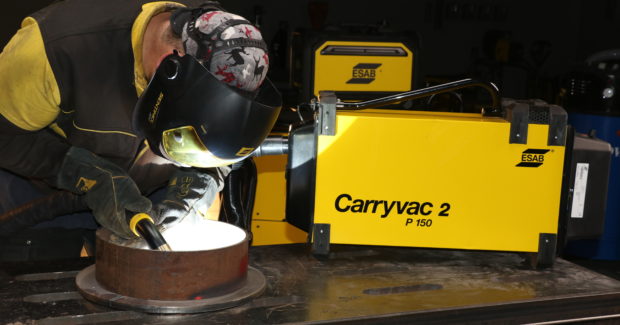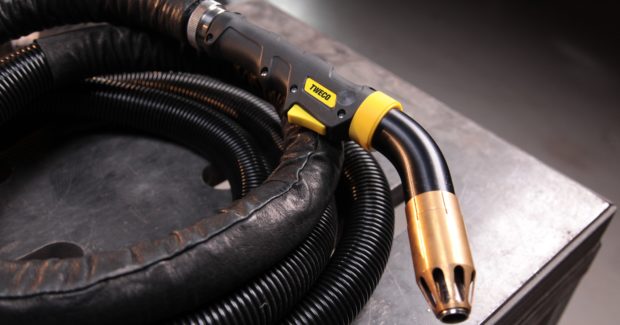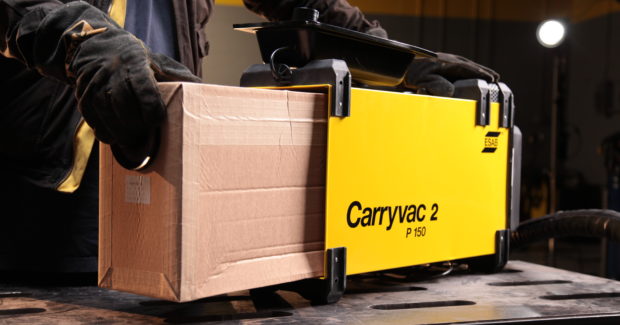Breathe Easier: Two Strategies for Fume Mitigation
Welders want a cleaner, low fume environment that keeps them more productive, comfortable and safer. Read on for tips on how best to clear the air.
Posted: February 3, 2022
Metal fabrication is physically a demanding job. There’s no need to make the job any harder by subjecting operators to unnecessary stress, such as by breathing dirty air. The fumes and particulates generated by welding, cutting, gouging and grinding create known hazards.
When working with steel, natural air movement through a work area is usually considered sufficient to avoid exposure if the room is large enough (10,000 cu. ft. for each welder), screens and partitions don’t block cross ventilation and welding is not done in a confined space. Spaces that cannot meet these requirements then need to use mechanical ventilation (fans) or local exhaust ventilation (fume hoods or downdraft tables).
However, when exposed to hexavalent chromium from welding stainless steel, zinc from welding galvanized material and manganese in many alloys poses additional hazards. Here, fabricators need to be aware of the OSHA Permissible Exposure Limits (PEL) and ACGIH Threshold Limit Values (TLV) specific to the metals and gases used. Additionally, when working in confined spaces and areas with poor ventilation, the oxygen level may fall below acceptable levels, while carbon dioxide and carbon monoxide may be unacceptably high.
In any of these instances, using a fume extraction MIG gun and/or a Powered Air-Purifying Respirator (PAPR) can help manage particulates, smoke and fumes and meet OSHA PEL and TLV requirements.
Smoke Sucking Guns
With a fume hood, operators need to be conscious about keeping their head out of the fume extraction flow. Fume extraction MIG guns have no such issues because they capture welding fumes at the source (Figure 1) to reduce particulates in the operator’s breathing zone and when working in confined areas, inside tanks or other situations with limited ventilation.
Fume extraction guns combine a MIG gun with a high static pressure suction device (think industrial-strength shop vac) that has a W class High Efficiency Particulate Air (HEPA) filter. At the front of the gun, an outer tube encircles the gun’s regular conductor tube, and an adjustable shroud is positioned over the standard gas nozzle (Figure 2). Users can control the volume of extraction by moving the shroud position relative to the end of the nozzle and with a vacuum vent located at the front of the handle that allows the operator to easily adjust fume extraction rates.
The amount of fumes extracted will vary between models, settings and applications, but fume extraction can extract more than 90 percent of fumes at the source. After being pulled through the gun, fumes and particulates move through a plastic tube (much like a vacuum cleaner hose) toward the power pin end of the gun. As with a standard gun cable, the hose is vulnerable to sharp objects, abrasion and spatter. Look for guns that have a leather or tough, resistant cover to protect all or some of the hose from a punction that will reduce its effectiveness.
About a foot from the feeder, the fume hose connects to the suction device via a T-piece, which removes particulates before they can reach the gun connection point. This minimizes fouling of the connection and wire feed mechanism.
To accommodate the vacuum system, fume extraction guns are larger than standard MIG guns. When evaluating guns, consider weight, grip comfort and such features as a steel knuckle joint between the gun and the cable. Like the ball joint on some models of standard guns, the knuckle will improve flexibility and motion, especially when welding around corners, as well as reduce perceived weight.
Portable Smoke Extractor
Portable suction systems provide the mobility required to maneuver in and around large weldments. They’re also the lowest cost solution for fabricators looking to convert just a few welding stations, and they can be implemented quickly compared to a centralized system (which does make better financial sense for those that need suction at a large number of welding cells because of lower long-term operating costs).
Portable suction systems that run on 115V power may be as small as a carry-on suitcase, have handles for carrying and weigh less than 35 pounds. Airflow volume may range from 150 to 200 l/min (Figure 3). Depending on the efficiency of the design, they may be powerful enough for extracting fumes in any welding position. Welding in the flat position requires less suction because the fumes rise and the gun is above the arc. Vertical or overhead positions require more extraction effort; if you need to weld in all positions, make sure the system has matching capabilities.
Larger portable systems, which roll on wheels, are about the size of a home water heater or furnace and may use 230V power for higher suction volume and pressure. Whatever the model, look for suction units with an automatic start/stop function that works by sensing arc voltage. This will increase the service life of the filter and reduces noise when not welding.
Depending on the system, filters can be cleanable or disposable (and disposed of properly). Filters come in three classes to match the application need:
- Class W1, which must have a filtration efficiency ≥ 95 percent. W1 filters are suitable for unalloyed or low-alloyed steel.
- Class W2, which must have a filtration efficiency ≥ 98 percent, are suitable for welding steel alloys with nickel and chromium components (five-to-30 percent composition).
- Class W3, which must have a filtration efficiency ≥ 99 percent, which are for working with high-alloy steel containing more than 30 percent nickel and chromium.
Introduction to PAPRs
When fume extraction guns are not enough, when required to meet OSHA regulations or when operators want the freshest air possible, the most common solution is adding a belt-worn powered air-purifying respirator (PAPR) unit to a PAPR-ready welding helmet.
The core of a PAPR is a blower unit powered by a rechargeable lithium-ion battery (Figure 4). To provide clean air, the blower pulls in air through a pre-filter to extract dust, then through a main filter that is specifically rated to remove welding fumes and particulates. The air then flows through a hose to supply clean, fresh air inside the helmet.
PAPR-equipped welding helmets offer the same optical and eye protection features of their standard counterparts but add features designed to work as part of a certified PAPR system. These PAPR-equipped helmets incorporate a flame-resistant hood that snugs around the head with a drawstring to create a barrier between the fresh air inside the helmet and welding fumes on the outside. Note that in many cases, the degree to which the hood prevents inward air leakage determines the effectiveness of a PAPR. A typical filter for a welding helmet PAPR is rated to remove 99.97 percent of particulates according to NIOSH standards. Welding PAPR systems do not require fit testing and will do their job as long as the helmet and integrated hood fit snugly.
Next let’s examine some the features and functions found on a typical PAPR. After turning on the unit, there should be some type of LCD display or LED battery level indicator and a control for airflow adjustment. A typical range might be 170 to 220 liters of air per hour. Advanced systems will use a microprocessor to control fan speed, ensuring the unit delivers the set flow rate. If the flow rate falls below set demand, an alarm will sound. Typically, this alarm means the battery needs to be recharged or the filter needs to be replaced.
Battery life is a common question, and it all depends on airflow rate. Most PAPRs can run between six-to-eight hours or more before they need recharging. For users concerned about lack of airflow during use, relax. PAPRs will sound visual, vibratory and audible alarms if the airflow falls below the minimum safe level. A quality PAPR unit will notify the user if the cause of the alarm is due to battery depletion or a clogged filter by way of a display or simple LEDs. Under normal use, filters need to be changed every one or two weeks. As a best practice, test the flow rate before each use using the flow rate meter provided with the PAPR, and then check the pre-filter and main filter at the end of the shift.
In an era where retaining skilled welders is a worldwide challenge, providing them with a cleaner, low fume environment that keeps them more productive, comfortable and safer is a winning solution.
For more information go to www.esabna.com.







